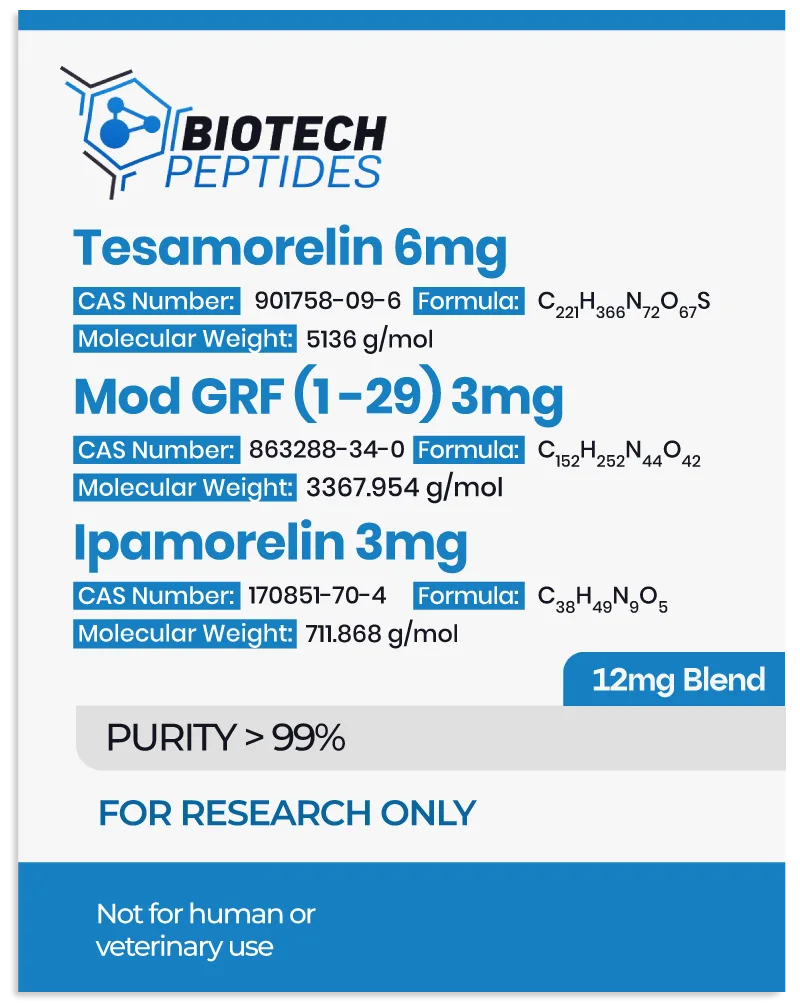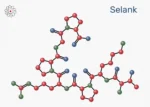Tesamorelin, functioning as a synthetic analogue of growth hormone-releasing hormone (GHRH), appears to exhibit a distinctive potential to elicit the production and release of endogenous growth hormone (GH). Empirical investigations indicate a discernible selectivity in activating GH-releasing hormone receptors within the pituitary gland. This selectivity augments its efficacy in manifesting the purported physiological effects.[1]
In the case of Modified GRF 1-29, this synthetic peptide manifests an extended half-life, likely attributable to its resistance to enzymatic degradation. It has been hypothesized to operate as a robust stimulator of GH secretion, showcasing considerable potential in fostering protein synthesis, facilitating muscle cell growth, and enhancing metabolic processes.[2]
Finally, Ipamorelin, a synthetic pentapeptide, has been suggested by researchers to operate as a selective agonist for the ghrelin receptor, thereby instigating the release of GH. Its noteworthy potential lies in a high specificity and minimal impact on other hormonal systems, positioning it as a valuable research instrument for precision-targeted GH stimulation.[3] This specific attribute renders Ipamorelin an invaluable tool for scientific inquiries directed at understanding and manipulating GH dynamics.
Contents:
Tesamorelin, Modified GRF and Ipamorelin Blend and Pituitary Gland
The synergy of Tesamorelin, Mod GRF 1-29, and Ipamorelin has been suggested through their substantive interactions with the pituitary gland. These interactions are characterized by precise receptor binding, leading to the modulation of growth hormone (GH) release.
Tesamorelin appears to exhibit an affinity for binding predominantly to growth hormone-releasing hormone (GHRH) receptors located on the surface of somatotrophs in the anterior pituitary gland. Upon this binding, Tesamorelin is speculated to initiate the activation of adenylate cyclase, thereby initiating the production of cyclic adenosine monophosphate (cAMP). This series of molecular events appears to carry the potential to induce the release of growth hormone (GH).[4] Meanwhile, Modified GRF, apparently engaging with GHRH receptors, emerges as a potential GH secretagogue. Its interaction with GHRH receptors is said to enhance GH release, concomitantly promoting protein synthesis, facilitating muscle cell growth, and amplifying metabolic processes—a phenomenon supported by speculative scientific research.
The structural configuration of the Modified GRF peptide, marked by four amino acid substitutions, appears to enhance its GH-related activity and fortifies its resistance against proteolytic enzymes. These structural modifications are purported to facilitate the covalent binding of “at least 90% of the peptide” to blood albumin, with trace amounts potentially binding to fibrinogen and immunoglobulin G (IgG).
Researchers report “No other chemical species have been found bound to DAC-GRF after [introduction]. This binding extends the half-life of the active pharmacophore, resulting in a markedly prolonged duration of action in several animal species.”[5]
In contrast, Ipamorelin appears to act as a selective agonist for the ghrelin receptor, which is also expressed on somatotrophs within the pituitary gland. Its binding to ghrelin receptors is posited to induce GH release with high specificity and minimal impact on other hormonal systems. Research findings underscore that Ipamorelin exposure may lead to heightened GH secretion without markedly affecting cortisol, prolactin, or insulin levels, thereby offering a prospect of more targeted and controlled GH stimulation.
Tesamorelin, Mod GRF 1-29 and Ipamorelin Blend and Gastrointestinal Tract
Within the trio of growth hormone-releasing peptides, Tesamorelin has been suggested by researchers to display an apparent capacity to augment gastric emptying and enhance gastrointestinal motility in animal models. Meanwhile, Modified GRF, while exhibiting a minimal impact, appears to contribute to the improvement of gut barrier function and the reduction of intestinal inflammation in animal research models of colitis. Ipamorelin is posited to predominantly interact with the ghrelin receptor within the gastrointestinal (GI) tract.
Following binding to the ghrelin receptors, Ipamorelin may evoke diverse responses, including the promotion of gut motility and the improvement of intestinal absorption. Additionally, Ipamorelin exhibits promise in mitigating inflammation and fostering tissue repair across various models of GI injury. Researchers assert that Ipamorelin may “increase total body fat percentages,” designating the peptide as a “potent and selective stimulator of GH that [may] significantly influence the GI system, body composition, and adiposity.”[7]
Tesamorelin, Modified GRF and Ipamorelin Blend and Cardiovascular System
Myocardial Infarction (MI) is recognized for inducing scarring in cardiac tissues, potentially compromising heart function, including parameters like ejection fraction.
Animal model studies suggest that growth hormone may expedite the repair of heart tissues post-MI, leading to a reduction in infarct size, enhancement of cardiac ejection fraction, and an overall improvement in cardiac function.[8]
Researchers observe that, “Through activation of GHS-R1a, secretagogues produced a positive inotropic effect on ischemic cardiomyocytes and protected them from I/R injury, likely by safeguarding or restoring p-PLB (and hence SR Ca2+ content) to facilitate the maintenance or recovery of normal cardiac contractility.”
Research underscores that Tesamorelin, beyond its potential in reducing lipodystrophy, may also contribute to notable reductions in triglyceride levels, total cholesterol levels, and non-HDL-C levels, especially among HIV-positive models.[9]
Synergistic Potential of Tesamorelin, Mod GRF 1-29 and Ipamorelin Blend
The amalgamation of these peptides is underpinned by the rationale rooted in their distinct mechanisms of action and the potential for synergistically enhanced growth hormone (GH) secretion.
An experimental study elucidated a synergistic augmentation in GH secretion when Tesamorelin and Modified GRF were combined, surpassing the effects observed with either peptide introduced individually. This synergistic hypothesis is attributed to the complementary mechanisms of action and receptor interactions inherent to these peptides.[6]
Notably, in research models of HIV-associated lipodystrophy, a combination of Tesamorelin and Ipamorelin exhibited more pronounced reductions in visceral adipose tissue compared to Tesamorelin in isolation. However, researchers caution that this effect is transient and reversible upon cessation of exposure.
Scientific research has documented diverse potential actions associated with this peptide blend, encompassing accelerated fat loss, improved sleep quality, mood enhancement, increased energy levels, and potential sustained long-term growth hormone (GH) production, particularly purported with the combined exposure of Ipamorelin and Modified GRF. The protracted elevation of GH production post-cycle may contribute to the enduring maintenance of these benefits over an extended period.
Tesamorelin assumes a pivotal role in enhancing the overall physiological framework of the body. Among the trio of growth hormone-releasing peptides, Tesamorelin is esteemed for its versatility. The concurrent introduction of these three peptides appears to yield a synergistic impact on GH secretion and insulin-like growth factor 1 (IGF-1) levels. This potential synergy may lead to heightened GH secretion, augmented muscle cell growth, improved bone density, cognitive enhancement, cellular repair and regeneration, fat loss, and other multifaceted physiological impacts.
Disclaimer: The products mentioned are not intended for human or animal consumption. Research chemicals are intended solely for laboratory experimentation and/or in-vitro testing. Bodily introduction of any sort is strictly prohibited by law. All purchases are limited to licensed researchers and/or qualified professionals. All information shared in this article is for educational purposes only.
References
- National Center for Biotechnology Information (2023). PubChem Compound Summary for CID 9831659, Ipamorelin. https://pubchem.ncbi.nlm.nih.gov/compound/Ipamorelin.
- National Center for Biotechnology Information (2023). PubChem Compound Summary for CID 56841945. https://pubchem.ncbi.nlm.nih.gov/compound/56841945.
- National Center for Biotechnology Information (2023). PubChem Compound Summary for CID 16137828, Tesamorelin. https://pubchem.ncbi.nlm.nih.gov/compound/Tesamorelin.
- Clinical and Research Information on Drug-Induced Liver Injury [Internet]. Bethesda (MD): National Institute of Diabetes and Digestive and Kidney Diseases; 2012-. Tesamorelin. [Updated 2018 Oct 20]. https://www.ncbi.nlm.nih.gov/books/NBK548730/
- Sam L. Teichman and others, Prolonged Stimulation of Growth Hormone (GH) and Insulin-Like Growth Factor I Secretion by CJC-1295, a Long-Acting Analog of GH-Releasing Hormone, in Healthy Adults, The Journal of Clinical Endocrinology & Metabolism, Volume 91, Issue 3, 1 March 2006, Pages 799–805, https://doi.org/10.1210/jc.2005-1536 ; https://academic.oup.com/jcem/article/91/3/799/2843281
- Bedimo R. Growth hormone and tesamorelin in the management of HIV-associated lipodystrophy. HIV AIDS (Auckl). 2011;3:69-79. doi: 10.2147/HIV.S14561. Epub 2011 Jul 10. PMID: 22096409; PMCID: PMC3218714. https://www.ncbi.nlm.nih.gov/pmc/articles/PMC3218714/
- Sinha DK, Balasubramanian A, Tatem AJ, Rivera-Mirabal J, Yu J, Kovac J, Pastuszak AW, Lipshultz LI. Beyond the androgen receptor: the role of growth hormone secretagogues in the modern management of body composition in hypogonadal males. Transl Androl Urol. 2020 Mar;9(Suppl 2):S149-S159. doi: 10.21037/tau.2019.11.30. PMID: 32257855; PMCID: PMC7108996 https://www.ncbi.nlm.nih.gov/pmc/articles/PMC7108996/
- Ma Y, Zhang L, Edwards JN, Launikonis BS, Chen C. Growth hormone secretagogues protect mouse cardiomyocytes from in vitro ischemia/reperfusion injury through regulation of intracellular calcium. PLoS One. 2012;7(4):e35265. https://journals.plos.org/plosone/article?id=10.1371/journal.pone.0035265 Epub 2012 Apr 6. PMID: 22493744; PMCID: PMC3320867.
- Stanley TL, Falutz J, Marsolais C, Morin J, Soulban G, Mamputu JC, Assaad H, Turner R, Grinspoon SK. Reduction in visceral adiposity is associated with an improved metabolic profile in HIV-infected patients receiving tesamorelin. Clin Infect Dis. 2012 Jun;54(11):1642-51. doi: 10.1093/cid/cis251. Epub 2012 Apr 10. PMID: 22495074; PMCID: PMC3348954. https://pubmed.ncbi.nlm.nih.gov/22495074/







